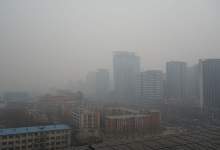

China does not hold back when it comes to infrastructure. When it came time to expand air capacity, following three straight decades of double digit growth, there was no drawn out period of consultation and public debate. In 2012, the Government simply announced that it was going to build 82 new airports, while also expanding 101, as part of their current five-year plan, which ends in 2015.
Such an approach to problem solving is not only applied in expanding aviation capacity. In addition to increasing demand for airports, China’s period of economic boom created rocketing demand for power, which was addressed in the typical fashion of a country that must ramp up energy supply quickly and cheaply – by building a large number of coal power stations. While the approach offered short-term effectiveness, it has brought long-term consequences, with large areas across the country engulfed with pollution from the output of the coal plants.
Smoked out
Earlier this year, capital city Beijing and six Northern provinces were covered in a thick, dense smog that lasted for more than two days. Monitoring of the Beijing air at the time found that there were 505 micrograms of smog particles small enough to enter the human blood stream per cubic metre, more than 20 times the level recommended by the World Health Organisation. Other consequences of the air quality crisis include the grounding of flights over poor visibility and a drop in tourism over health concerns, while concerns have been raised over the long-term impact on agriculture, warning that farmers would face "nuclear winter" like conditions.
Power-technology.com profiles the ten biggest Chinese power stations based on installed capacity.
Now that the problem has reached such drastic levels, the government has responded with a solution of equally dramatic scale. In order to remove the smog generated by the coal plants, China has approved the construction of nine synthetic natural gas (SNG) plants and is expected to approve at least a further 30 plants. Once completed, the plants will burn coal and convert it into gas, while removing the harmful air that has created the smog. The ambition of the plan is illustrated by the fact that the Great Plains Synfuels Plant in Beulah, North Dakota,which has been in operation for over 25 years, remains the only one in the world.
Carbon crisis
While there are multiple criticisms of the SNG process, what has garnered the most attention is that it increases the amount of carbon emittedand would therefore be counter-productive in China’s pursuit of its 2020 climate change goals.
Last year, a peer-reviewed study published in Energy Policy reported that SNG generated up to 108% more carbon throughout the entire life-cycle when compared with conventional coal. The same paper argued that the strategy proposed by China was at odds with its 2020 carbon targets.Li Junfeng, director general of the National Centre for Climate Change Strategy and International Cooperation, said: "This kind of thinking is just wrong. It’s just a stopgap measure to do this now."
Environmental campaigning group Greenpeace, one of a number of environmental groups to strongly criticise the strategy, estimated that if 28 plants were built, they would release 402 million tons of carbon a year, more than the 396 tons that the US must cut out by 2020. In a translated quote, Zhou Tong, dean of the Research Institute of Coal Industry Planning and Design, said: "This is a process of pollution transfer which I feel is not rational. It is neither desirable, nor feasible to keep yourself clean by piling the garbage at your neighbour’s door."
Wrong route to right destination
In addition to reducing air pollution, the policy also offers China the opportunity to significantly increase its natural gas production, in turn reducing its reliance on imports of foreign gas.The country is significantly increasing the use of gas in order to reduce its reliance on oil and coal and recently signed a 30-year deal worth $400bn with the Russian state-owned gas company Gazprom.
The push to move away from oil and coal and towards gas has been well received, but the approach of coal gasification is not seen as the right option. "Replacing oil with gas is the right path, but making gas from coal – coal gasification – will lead us astray," said Tao Guabgyuan, executive director of the Sino-German Renewable Energy Centre."
Researchers at DukeUniversity have argued that the economic argument of moving to gas may not be as strong as suggested. Chi-Jen Yang and Robert B. Jackson of the Centre on Global Change at Duke, compared the situation in China to the US in the 1980s when it built its first and only SNG plant.
Off the back of recent success in the demand response market in the UK, London-based start up Kiwi Power was invited to join the Prime Minister on a trade mission to China.
Explaining what happened in the US, they wrote: "After the USA decontrolled natural gas prices in the 1980s, increased investments in exploration and extraction technologies made natural gas more abundant, reducing the economic viability of SNG but locking in its extensive environmental costs."
Relating the events in America, they wrote: "At a minimum, Chinese policymakers should delay implementing their SNG plan to avoid a potentially costly and environmentally damaging outcome. An even better decision would be to cancel the program entirely."
While criticism of the move to coal gasification has been fierce, China appears unconcerned and is pressing ahead. Unsurprisingly, it is not prone to factor in international concern when dealing with domestics such as energy policy. However, with the 2015 United Nations Climate Change Conference less than three months away, pressure is likely to intensify as the international community attempts to see just how serious China is about delivering its climate change obligations.


.gif)

